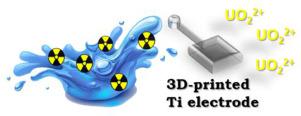Applied Materials Today ( IF 8.3 ) Pub Date : 2020-11-25 , DOI: 10.1016/j.apmt.2020.100881 Veronika Urbanová , Martin Pumera

|
Uranium can cause significant pollution of the ecosystem as well as it can have immense hazardous effect on human health due to its chemical and radioactive toxicity. Uranyl ions (UO22+) are considered as the most common and stable ionic form of uranium and additionally, UO22+ can spread easily through the environment owing to their high solubility and mobility in water. Hence, the development of appropriate sensors for UO22+ detection is very important for in time revelation of potentially dangerous sources of water or soil contamination. 3D-printing technology is now recognized as effective tool for designing and manufacturing objects of different sizes and shapes. Thus, it might also offer customized solution for design of electrodes to be applied in environmental sensing. In this work, 3D-printed titanium electrode was evaluated toward uranyl ions determination in aqueous samples. This electrode revealed good liner response within the wide concentration range, high stability as well as reproducibility. Good analytical performance of 3D-Ti electrode was further confirmed by low detection limit of 24.5 µg L−1 that also meets the requirement of Maximum Contaminant Level (MCL) for uranium in drinking water (30 µg L−1). The performance of 3D-Ti electrode was also evaluated for its capability of UO22+ determination in spiked tap and mineral water. All results presented in this work, encourage and highlight the exploitation of 3D-printing technology for electrochemical sensing applications since it has strong potential for environmental, nuclear forensic and security applications.
中文翻译:

通过3D打印的钛结构进行铀检测:朝着分散核法证学的方向发展
铀会因其化学和放射性毒性而对生态系统造成严重污染,并对人类健康产生巨大危害。铀酰离子(UO 2 2+)被认为是铀的最常见和稳定的离子形式,此外,由于UO 2 2+在水中的高溶解度和迁移性,因此可以很容易地在环境中扩散。因此,开发了适用于UO 2 2+的传感器对于及时发现潜在危险的水或土壤污染源,检测非常重要。3D打印技术现已被认为是设计和制造不同尺寸和形状的物体的有效工具。因此,它也可以为在环境传感中应用的电极设计提供定制的解决方案。在这项工作中,对3D打印的钛电极进行了水溶液样品中铀酰离子测定的评估。该电极在宽浓度范围内表现出良好的衬里响应,高稳定性以及可重复性。低检测限24.5 µg L -1进一步证实了3D-Ti电极的良好分析性能,该检测限还满足饮用水中铀的最大污染水平(MCL)(30 µg L -1)。还评估了3D-Ti电极在加标自来水和矿泉水中的UO 2 2+测定能力。这项工作中提出的所有结果,都鼓励并强调了3D打印技术在电化学传感应用中的应用,因为3D打印技术在环境,核法证和安全应用方面具有强大的潜力。



























 京公网安备 11010802027423号
京公网安备 11010802027423号